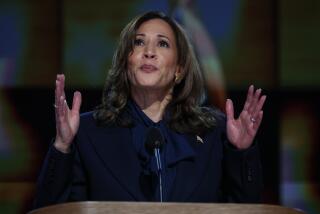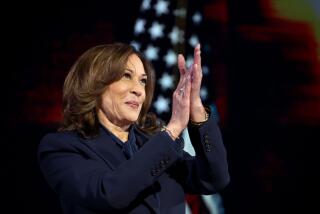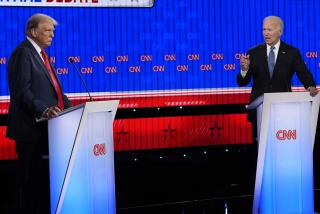More people say they’re liberal, but the electorate might not follow

Three NBC/Wall St. Journal surveys this year find a significant increase in the percentage of Americans who call themselves liberals and a decline of conservatives. Above, a polling place in Cedar Falls, Iowa.
More Americans call themselves liberals than did just a few years ago. Should conservatives be worried?
A lot depends on whether the increasing number of liberals means that the center of the electorate has moved left -- something that would be a big problem for conservatives -- or whether it means that the country has simply become more polarized, with more liberals, more conservatives and fewer moderates.
On that question, the evidence is mixed.
This week, Bill McInturff, one of the most experienced pollsters on the Republican side, kicked off a debate among political analysts with a blog post about the findings of the NBC/Wall St. Journal poll, which he helps to direct.
After years in which the ideological mix in the U.S. had stayed about the same, he wrote, three NBC/Wall St. Journal surveys this year had found a significant increase in the percentage of Americans who call themselves liberals and a decline of conservatives.
The share of registered voters in the U.S. who call themselves liberal had climbed from 23% to 26%, he wrote. The share calling themselves conservative had dropped from 37% to 33%. A 14-point conservative advantage had shrunk suddenly to a seven-point one.
The shift is “quite large considering how stable the data has been,” McInturff wrote. Since the 2012 presidential election was decided by just under 4 percentage points, the shift in the liberal direction is big enough to suggest a new hurdle for Republicans.
Other polls, however, paint a somewhat different picture.
In the nation’s largest state, the ideological breakdown has also moved to the left, but most of the movement has occurred within Democratic ranks, according to an analysis of several years of USC Dornsife/L.A. Times polls.
Since 2009, the ideological split among California voters has gone from 35% conservative and 26% liberal to 29% conservative and 32% liberal, said David Kanevsky of the Republican firm American Viewpoint, who helps direct the poll. A nine-point conservative advantage has become a three-point liberal one. The share of moderates has remained fairly constant, at about one-third of the electorate.
Part of that shift involves demographics -- more members of the millennial generation, who tend to be liberals, have become voters.
But the bigger part involves the state’s Democrats. In 2009, only 39% of registered Democrats in California identified themselves as liberals; most called themselves moderates. Today, 50% of Democrats in California identify as liberal, the polls showed.
The shift corresponds with President Obama’s years in the White House, suggesting that “Obama has successfully moved the Democratic Party to the left,” Kanevsky said.
If Democrats are becoming more liberal, much as Republicans have become more conservative, that would deepen the country’s political polarization. It wouldn’t necessarily change which side wins elections, but would forecast even less cooperation between the two parties when the elections are over.
A different look comes from polling expert Harry Enten, who examined data from polls going back to 2007 done by the Kaiser Family Foundation.
Much like the NBC/Wall St. Journal surveys, the Kaiser polls find more liberals in the U.S. They did not, however, find fewer conservatives.
In the Kaiser data, Enten found, the share of conservatives has remained relatively constant, at about 35%. In that poll, the growth among liberals was coming at the expense of self-described moderates.
The NBC/Wall St. Journal numbers indicate an overall shift toward the left. The Kaiser numbers, by contrast, indicate a decline of the center.
There’s at least one important difference between the Kaiser polls and the NBC/Wall St. Journal data: Kaiser polled all American adults, while the NBC/Wall St. Journal survey looked only at registered voters. Since about 30% of American adults don’t register to vote, trends can affect the two groups differently.
One final bit of data comes from a Gallup survey last month, which showed that when Americans were asked how they felt about “social issues,” the answers showed a leftward shift overall -- more liberals, fewer conservatives.
Asking about “economic issues,” however, led to a different pattern: fewer conservatives, but more moderates.
Out of all those numbers, a few messages seem clear: Democrats have become more consistently liberal. That’s already having an impact in the issues that Hillary Rodham Clinton is stressing as she runs for the party’s presidential nomination.
Americans overall have shifted to the left on social issues -- that can be seen most clearly in the huge change in views of same-sex marriage. That shift has created problems for the GOP that will probably continue to at least some extent through the coming election cycle.
What’s still unclear is whether the increase in liberals has come about because of a decline in the center, as the Kaiser figures suggest, or because of a shift away from conservatives, as the NBC/Wall St. Journal numbers imply. Both sides will be studying that question, with a lot riding on the answer.
For more on politics and policy, follow @DavidLauter on Twitter.
More to Read
Get the L.A. Times Politics newsletter
Deeply reported insights into legislation, politics and policy from Sacramento, Washington and beyond. In your inbox three times per week.
You may occasionally receive promotional content from the Los Angeles Times.











